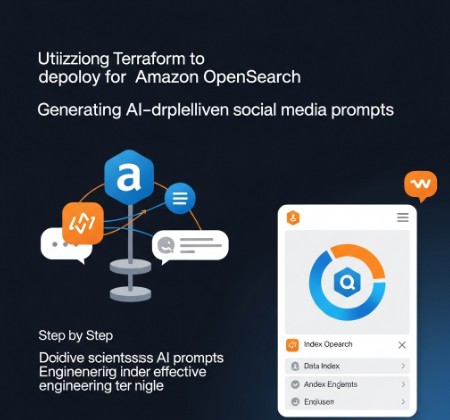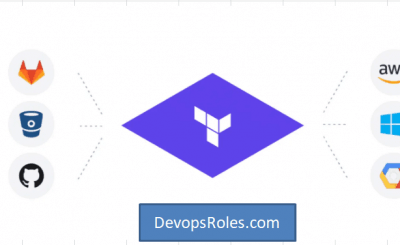The explosion of AI-powered tools has revolutionized various sectors, and social media marketing is no exception. Generating engaging content is crucial for success, and AI social media prompts offer a powerful solution. However, effectively utilizing these prompts often requires robust infrastructure capable of handling the data processing and model deployment.
This comprehensive guide explains how to leverage Terraform, a popular Infrastructure as Code (IaC) tool, to provision and manage an Amazon OpenSearch Service (Amazon OpenSearch) cluster optimized for AI social media prompts. We’ll explore how this approach streamlines the deployment process, enhances scalability, and provides a more efficient workflow for managing your AI-powered social media strategy.
Table of Contents
- 1 Understanding the Role of Amazon OpenSearch in AI Social Media Prompts
- 2 Terraform: Automating Amazon OpenSearch Deployment for AI Social Media Prompts
- 3 Generating AI Social Media Prompts with Amazon OpenSearch
- 4 AI Social Media Prompts: Optimizing Your Strategy
- 5 Frequently Asked Questions
- 5.1 Q1: What are the cost implications of using Amazon OpenSearch with Terraform?
- 5.2 Q2: How secure is Amazon OpenSearch when used with Terraform?
- 5.3 Q3: Can I use Terraform to manage multiple OpenSearch clusters?
- 5.4 Q4: What are the alternatives to Amazon OpenSearch for handling AI social media prompts?
- 6 Conclusion
Understanding the Role of Amazon OpenSearch in AI Social Media Prompts
AI social media prompts, whether for generating captions, tweets, or other content formats, often involve processing vast amounts of data. This data may include past posts, audience demographics, trending topics, and even sentiment analysis results. Amazon OpenSearch, a powerful and highly scalable search and analytics service, offers a robust solution for storing, querying, and analyzing this data. Its flexibility allows you to incorporate various data sources and use advanced analytics techniques to improve the performance and effectiveness of your AI prompt generation system.
Key Benefits of Using Amazon OpenSearch
- Scalability: Easily handle growing data volumes and increasing user demands.
- Cost-Effectiveness: Pay only for what you use, reducing infrastructure management costs.
- Security: Benefit from Amazon’s robust security infrastructure and features.
- Integration: Seamlessly integrate with other AWS services and your existing data pipelines.
Terraform: Automating Amazon OpenSearch Deployment for AI Social Media Prompts
Manually setting up and configuring an Amazon OpenSearch cluster can be time-consuming and error-prone. Terraform automates this process, ensuring consistency, repeatability, and reducing human error. It allows you to define your infrastructure as code, managing all aspects of your OpenSearch cluster, including domain creation, node configuration, and security settings. This is particularly beneficial when dealing with AI social media prompts as the infrastructure needs to scale efficiently to handle the processing of large amounts of textual data.
Building a Terraform Configuration for Amazon OpenSearch
Here’s a basic example of a Terraform configuration to create an Amazon OpenSearch domain:
terraform {
required_providers {
aws = {
source = "hashicorp/aws"
version = "~> 4.0"
}
}
}
provider "aws" {
region = "us-west-2" # Replace with your desired region
}
resource "aws_opensearch_domain" "default" {
domain_name = "my-opensearch-domain"
engine_version = "2.0"
cluster_config {
instance_type = "t3.medium.search"
instance_count = 3
}
ebs_options {
ebs_enabled = true
volume_size = 10
volume_type = "gp2"
}
tags = {
Name = "My OpenSearch Domain"
}
}This code snippet creates a basic OpenSearch domain. You would need to adjust settings such as instance type, instance count, and EBS options based on your specific needs and the scale of your AI social media prompts processing.
Advanced Configuration Options
For more advanced use cases involving AI social media prompts, you might need to consider:
- Access Policies: Carefully manage access control to protect your data.
- Data Encryption: Utilize encryption at rest and in transit for enhanced security.
- Automated Scaling: Configure autoscaling to handle fluctuating workloads during peak activity.
- Integration with other AWS services: Connect OpenSearch with other services like AWS Lambda for real-time processing of social media data and AI prompt generation.
Generating AI Social Media Prompts with Amazon OpenSearch
Once your Amazon OpenSearch cluster is set up using Terraform, you can integrate it into your AI social media prompt generation pipeline. This might involve using a machine learning model trained on your historical data, stored and indexed in OpenSearch. The model could then use the data to generate fresh and engaging prompts tailored to your audience and current trends.
Example Workflow:
- Data Ingestion: Collect data from various sources (social media APIs, internal databases, etc.).
- Data Processing: Clean, transform, and pre-process the data for OpenSearch.
- Data Indexing: Index the pre-processed data into your Amazon OpenSearch cluster.
- Prompt Generation: Use a trained machine learning model (e.g., a large language model) to query OpenSearch for relevant data and generate AI social media prompts.
- Post-processing and Deployment: Refine the generated prompts and publish them to your social media channels.
Remember to regularly monitor the performance of your Amazon OpenSearch cluster and adjust its configuration as needed to ensure optimal performance and handle the demands of your AI social media prompts generation process.
AI Social Media Prompts: Optimizing Your Strategy
Generating effective AI social media prompts requires a well-defined strategy. This goes beyond just technical infrastructure; it also involves understanding your audience, defining your goals, and choosing the right AI models and techniques. Consider incorporating sentiment analysis into your prompt generation process to tailor your messaging based on audience feedback. Monitor campaign performance and iterate based on data insights to further optimize your social media strategy.
Frequently Asked Questions
Q1: What are the cost implications of using Amazon OpenSearch with Terraform?
The cost of using Amazon OpenSearch depends on factors such as the instance type, storage used, and data transfer. Terraform helps manage costs by automating provisioning and allowing for precise control over resource allocation. Use the AWS pricing calculator to estimate the costs based on your specific configuration.
Q2: How secure is Amazon OpenSearch when used with Terraform?
Amazon OpenSearch inherently offers strong security features. Terraform allows you to enforce security policies and manage access control through code, improving security posture. Implement security best practices like data encryption and appropriate IAM policies for enhanced protection.
Q3: Can I use Terraform to manage multiple OpenSearch clusters?
Yes, Terraform allows you to manage multiple OpenSearch clusters by defining multiple resources within the same configuration or in separate configurations. This is particularly useful for separating development, testing, and production environments.
Alternatives include Elasticsearch (self-hosted), other cloud-based search and analytics services, and potentially specialized database solutions for handling text data and machine learning models.

Conclusion
Successfully implementing AI social media prompts requires a robust and scalable infrastructure. This guide has demonstrated how Terraform simplifies the deployment and management of an Amazon OpenSearch cluster, providing a foundation for your AI-powered social media strategy.
By leveraging Terraform’s capabilities, you can automate the process, improve efficiency, and focus on optimizing your AI social media prompts for maximum engagement and results. Remember to continuously monitor and refine your infrastructure and AI models to adapt to evolving needs and maximize the impact of your campaigns.
For further information on Terraform, refer to the official documentation: Terraform Official Documentation. For more details on Amazon OpenSearch, visit: Amazon OpenSearch Service. Thank you for reading the DevopsRoles page!
